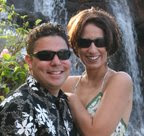The tactile sense is the sense of touch. Tactile dysfunction is the inefficient processing in the central nervous system of sensations perceived through the skin.
In today's blog, I will be using Carol Stock Kranowitz' book, The Out-of-Sync Child, as my main source of reference for this information. I will be concentrating on the tactile sense today, but there are other senses that need to be and will be discussed in later blogs.
Tactile Sense at Work
A normal tactile sense lets us know when something feels nice and when something feels wrong. We can sense danger through touch (self preservation), as well as enjoy touch. Touch lets us know when someone is "too close" to us or if something is "too hot" for us. Normal tactile sense allows us to discriminate what kind of touch we are feeling.
Tactile Dysfunction
Children can be tactile defensive (overresponsive) - they respond negatively to unexpected, light touch senstations; uncomfortable with touch; will over respond with a fight, flight, fright or freeze response
Children can be tactile underersponisive -they disregard touch --soothing or painful; may not be able to self-protect because he can't 'sense' anything touching him
Children can be tactile sensory seeking - they crave deep pressure, more skin contact than most, touch & feel everything in sight, handle things that other children understand are 'no-nos'; they just have to touch it; intense & impulsive; loves messy play, crams mouth with food; gets too close to other people - can touch to the point of annoyance
The tactile sense affects everyday skills, such as body awareness, motor planning, visual discrimination, language, academic learning, emotional security, and social skills.
"The child with poor tactile awareness in his mouth, lips, tongue, and jaw may have a sensory-based motor problem called oral apraxia, which affects his ability to produce and sequence sounds necessary for speech". quoted from The Out-of-Sync Child by Carol Stock Kranowitz.
How Tactile Dysfunction affects John
I see John with a Sensory Seeking Tactile dysfunction. In this section of the Kranowitz' book, there is a checklist. In the Sensory Seeking category for Tactile dysfunction, I checked 12 of the 15 options. In the other categories, I checked 0 of 17 boxes for over responsive to being touched, 0 of 17 for over responsive to active touch, 4 of 14 for Under responsive and then 12 of 15 for sensory seeking. (the ones I didn't check in that category were 1. twirls hair in fingers 2. seeks really cold or really hot bath water 3. prefers steaming hot, icy cold, or spicy food )
Subscribe to:
Post Comments (Atom)




No comments:
Post a Comment